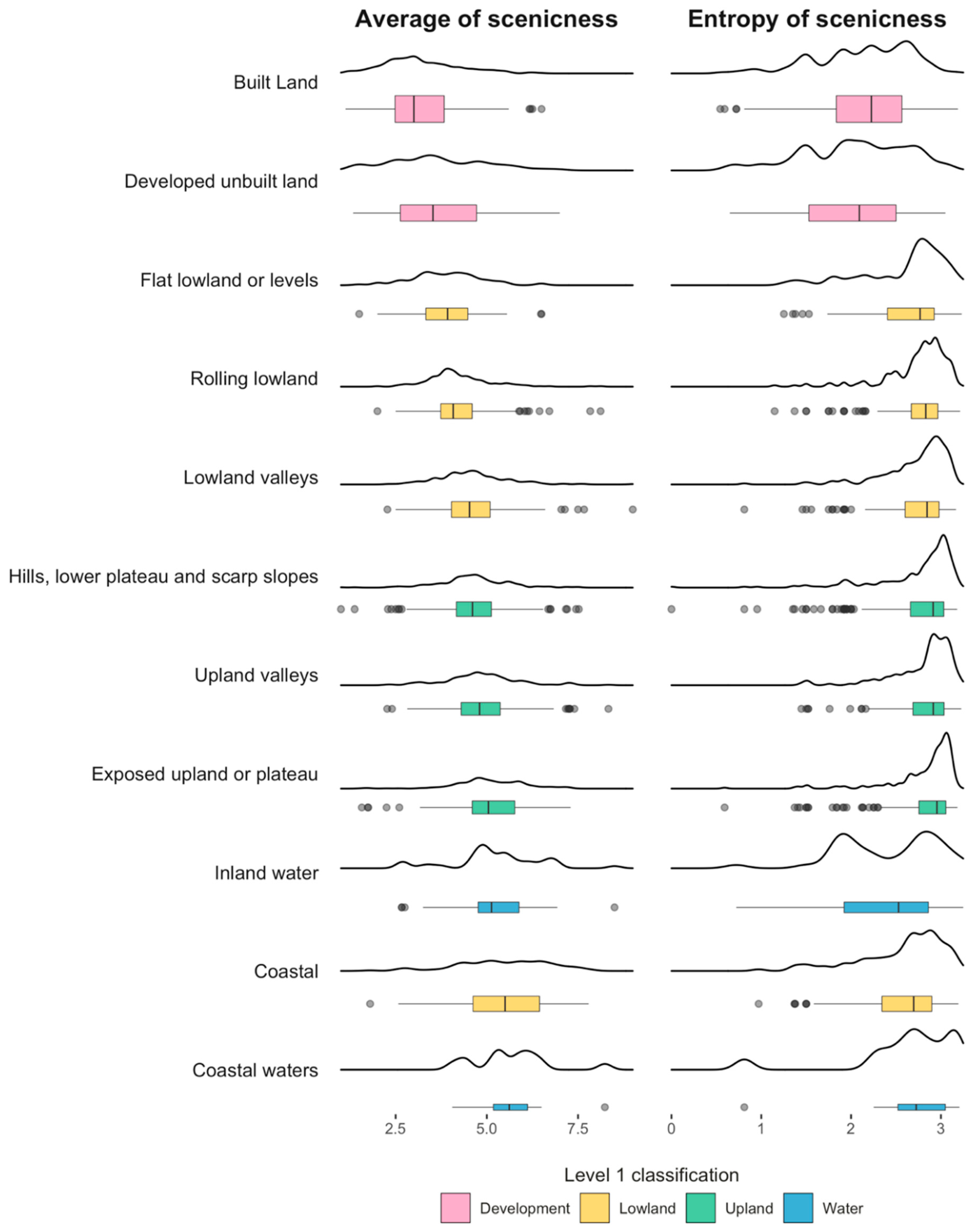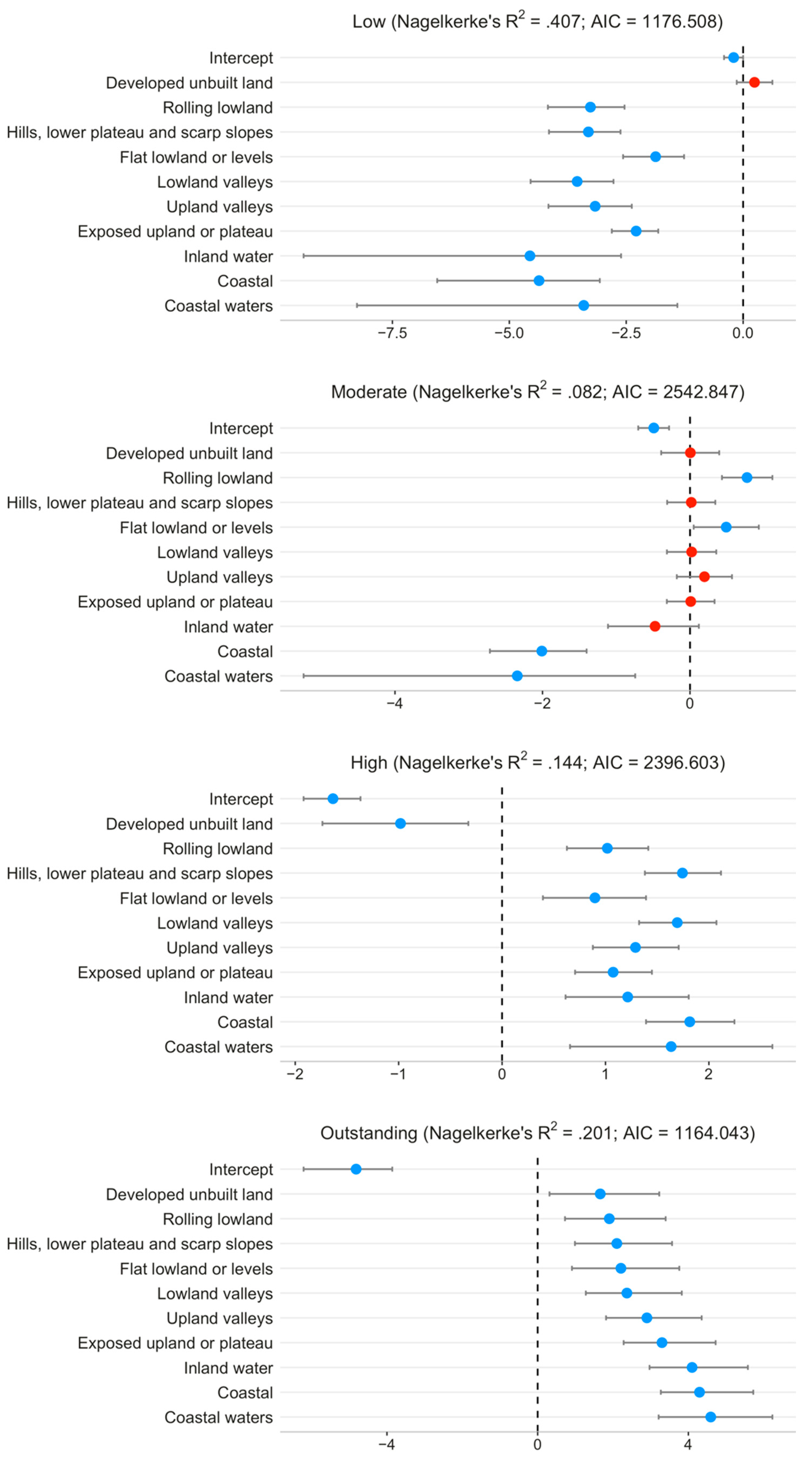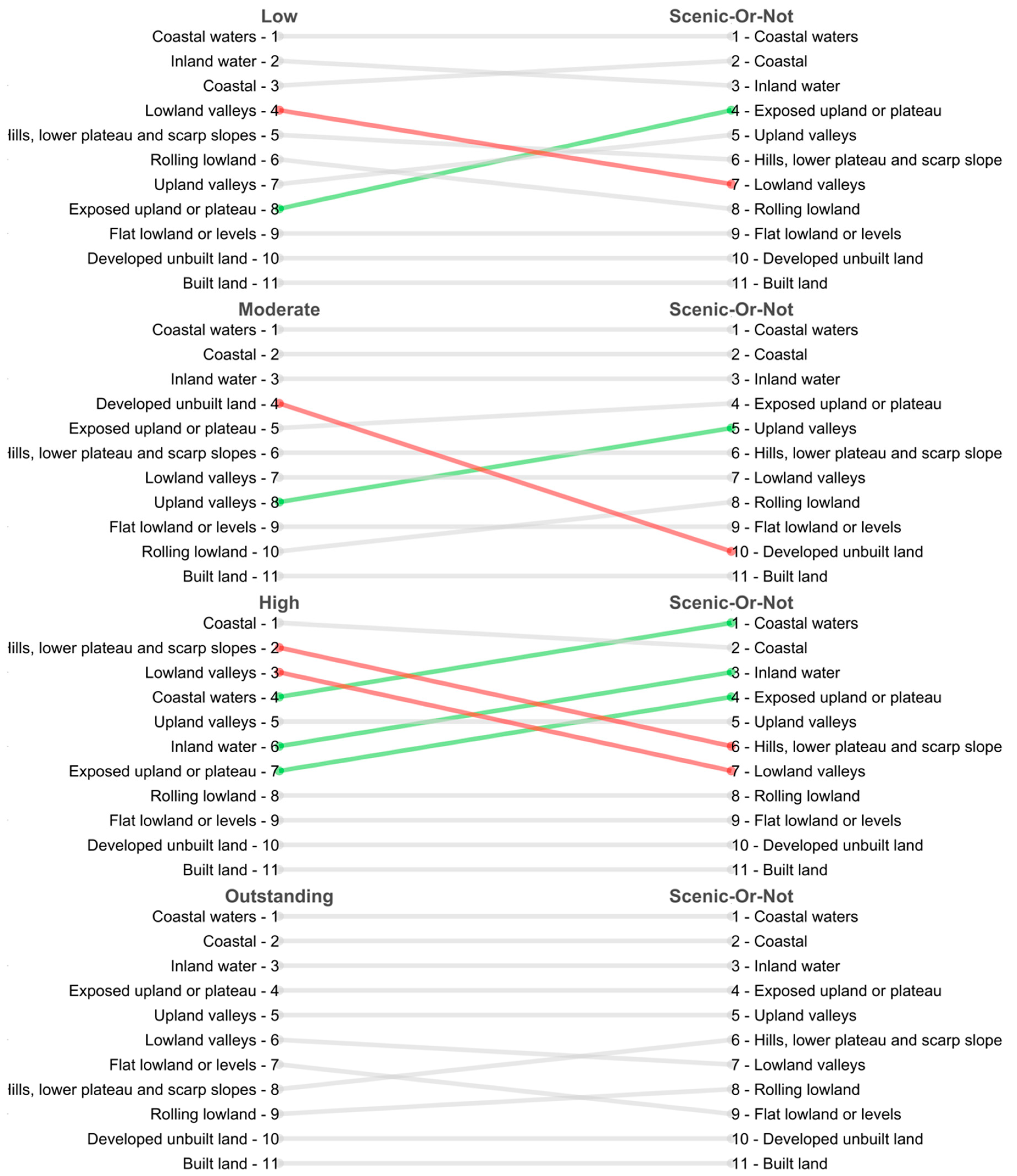An Exploratory Analysis of Expert and Nonexpert-Based Land-Scape Aesthetics Evaluations: A Case Study from Wales
Abstract
:1. Introduction
2. Data and Methods
2.1. Study Area
2.2. Data
2.2.1. LANDMAP Visual and Sensory Aspect
2.2.2. Scenic-Or-Not
2.3. Methods
2.3.1. Shannon Entropy
2.3.2. Generalised Linear Model
3. Results
3.1. Exploratory Analysis
3.2. Variability of Public Perceptions on Scenic Beauty
3.3. Summary of Expert Perspectives
3.4. Summary of Non-Expert Perspectives
3.5. Comparison of Perspectives between Experts and Non-Experts
4. Discussion
4.1. Implications for LCA
4.2. Limitations and Outlook
5. Conclusions
Author Contributions
Funding
Data Availability Statement
Acknowledgments
Conflicts of Interest
References
- Lothian, A. Landscape and the Philosophy of Aesthetics: Is Landscape Quality Inherent in the Landscape or in the Eye of the Beholder? Landsc. Urban Plan. 1999, 44, 177–198. [Google Scholar] [CrossRef]
- Daniel, T.C. Whither Scenic Beauty? Visual Landscape Quality Assessment in the 21st Century. Landsc. Urban Plan. 2001, 54, 267–281. [Google Scholar] [CrossRef]
- Antrop, M.; Van Eetvelde, V. Landscape Perspectives; Landscape Series; Springer: Dordrecht, The Netherlands, 2017; Volume 23. [Google Scholar] [CrossRef]
- Bubalo, M.; van Zanten, B.T.; Verburg, P.H. Crowdsourcing Geo-Information on Landscape Perceptions and Preferences: A Review. Landsc. Urban Plan. 2019, 184, 101–111. [Google Scholar] [CrossRef]
- Dunkel, A. Visualizing the Perceived Environment Using Crowdsourced Photo Geodata. Landsc. Urban Plan. 2015, 142, 173–186. [Google Scholar] [CrossRef]
- Zube, E.H.; Pitt, D.G. Cross-Cultural Perceptions of Scenic and Heritage Landscapes. Landsc. Plan. 1981, 8, 69–87. [Google Scholar] [CrossRef]
- Dramstad, W.E.; Tveit, M.S.; Fjellstad, W.J.; Fry, G.L.A. Relationships between Visual Landscape Preferences and Map-Based Indicators of Landscape Structure. Landsc. Urban Plan. 2006, 78, 465–474. [Google Scholar] [CrossRef]
- Simensen, T.; Halvorsen, R.; Erikstad, L. Methods for Landscape Characterisation and Mapping: A Systematic Review. Land Use Policy 2018, 75, 557–569. [Google Scholar] [CrossRef]
- Gosal, A.S.; Ziv, G. Landscape Aesthetics: Spatial Modelling and Mapping Using Social Media Images and Machine Learning. Ecol. Indic. 2020, 117, 106638. [Google Scholar] [CrossRef]
- Terkenli, T.S. Towards a Theory of the Landscape: The Aegean Landscape as a Cultural Image. Landsc. Urban Plan. 2001, 57, 197–208. [Google Scholar] [CrossRef]
- Council of Europe. The European Landscape Convention. ETS No. 176. Available online: https://www.coe.int/en/web/conventions/full-list/-/conventions/rms/0900001680080621 (accessed on 20 October 2020).
- Santé, I.; Tubío, J.M.; Miranda, D. Public Participation in Defining Landscape Planning Scenarios and Landscape Quality Objectives (LQO): Landscape Guidelines for Galicia (NW Spain) Case Study. Land Use Policy 2020, 94, 104559. [Google Scholar] [CrossRef]
- Jones, M. The European Landscape Convention and the Question of Public Participation. Landsc. Res. 2007, 32, 613–633. [Google Scholar] [CrossRef]
- Conrad, E.; Christie, M.; Fazey, I. Is Research Keeping up with Changes in Landscape Policy? A Review of the Literature. J. Environ. Manag. 2011, 92, 2097–2108. [Google Scholar] [CrossRef] [Green Version]
- Swanwick, C. Landscape Character Assessment: Guidance for England and Scotland; Countryside Agency and Scottish Natural Heritage: Cheltenham, UK; Edinburgh, UK, 2002. [Google Scholar]
- Butler, A. Dynamics of Integrating Landscape Values in Landscape Character Assessment: The Hidden Dominance of the Objective Outsider. Landsc. Res. 2016, 41, 239–252. [Google Scholar] [CrossRef] [Green Version]
- Conrad, E.; Cassar, L.F.; Jones, M.; Eiter, S.; Izaovičová, Z.; Barankova, Z.; Christie, M.; Fazey, I. Rhetoric and Reporting of Public Participation in Landscape Policy. J. Environ. Policy Plan. 2011, 13, 23–47. [Google Scholar] [CrossRef]
- Groom, G.; Wascher, D.M.; Potschin, M.; Haines-Young, R. Landscape Character Assessments and Fellow Travelers across Europe: A Review. In Landscape Ecology in the Mediterranean: Inside and Outside Approaches, 3rd ed.; IALE: Darwin, Australia, 2003; pp. 227–231. [Google Scholar]
- Crofts, R.S. The Landscape Component Approach to Landscape Evaluation. Trans. Inst. Br. Geogr. 1975, 124–129. [Google Scholar] [CrossRef]
- Arriaza, M.; Cañas-Ortega, J.F.; Cañas-Madueño, J.A.; Ruiz-Aviles, P. Assessing the Visual Quality of Rural Landscapes. Landsc. Urban Plan. 2004, 69, 115–125. [Google Scholar] [CrossRef]
- Tenerelli, P.; Demšar, U.; Luque, S. Crowdsourcing Indicators for Cultural Ecosystem Services: A Geographically Weighted Approach for Mountain Landscapes. Ecol. Indic. 2016, 64, 237–248. [Google Scholar] [CrossRef] [Green Version]
- van Zanten, B.T.; Van Berkel, D.B.; Meentemeyer, R.K.; Smith, J.W.; Tieskens, K.F.; Verburg, P.H. Continental-Scale Quantification of Landscape Values Using Social Media Data. Proc. Natl. Acad. Sci. USA 2016, 113, 12974–12979. [Google Scholar] [CrossRef] [Green Version]
- Goodchild, M.F. Citizens as Sensors: The World of Volunteered Geography. GeoJournal 2007, 69, 211–221. [Google Scholar] [CrossRef] [Green Version]
- Seresinhe, C.I.; Preis, T.; Moat, H.S. Quantifying the Impact of Scenic Environments on Health. Sci. Rep. 2015, 5, 16899. [Google Scholar] [CrossRef] [Green Version]
- Seresinhe, C.I.; Preis, T.; MacKerron, G.; Moat, H.S. Happiness Is Greater in More Scenic Locations. Sci. Rep. 2019, 9, 4498. [Google Scholar] [CrossRef] [PubMed] [Green Version]
- Seresinhe, C.I.; Preis, T.; Moat, H.S. Using Deep Learning to Quantify the Beauty of Outdoor Places. R. Soc. Open Sci. 2017, 4, 170170. [Google Scholar] [CrossRef] [PubMed] [Green Version]
- Seresinhe, C.I.; Moat, H.S.; Preis, T. Quantifying Scenic Areas Using Crowdsourced Data. Environ. Plan. B Urban Anal. City Sci. 2018, 45, 567–582. [Google Scholar] [CrossRef] [Green Version]
- Chesnokova, O.; Nowak, M.; Purves, R.S. A Crowdsourced Model of Landscape Preference. In Proceedings of the 13th International Conference on Spatial Information Theory (COSIT 2017), L’Aquila, Italy, 4–8 September 2017; pp. 1–13. [Google Scholar] [CrossRef]
- Unwin, K.I. The Relationship of Observer and Landscape in Landscape Evaluation. Trans. Inst. Br. Geogr. 2006, 130. [Google Scholar] [CrossRef]
- Gyllin, M.; Grahn, P. Semantic Assessments of Experienced Biodiversity from Photographs and On-Site Observations—A Comparison. Environ. Nat. Resour. Res. 2015, 5, 46. [Google Scholar] [CrossRef] [Green Version]
- Weledol, M.; Landmap, S. LANDMAP Methodology Visual and Sensory; Natural Resources Wales: Cardiff, UK, 2016.
- Natural Resources Wales. LANDMAP Guidance Note 1: LANDMAP and Special Landscape Areas; Natural Resources Wales: Cardiff, UK, 2017.
- Shannon, C.E. A Mathematical Theory of Communication. Bell Syst. Tech. J. 1948, 27, 379–423. [Google Scholar] [CrossRef] [Green Version]
- Myers, R.H.; Montgomery, D.C. A Tutorial on Generalized Linear Models. J. Qual. Tech. 1997, 29, 274–291. [Google Scholar] [CrossRef]
- Brown, G.; Brabyn, L. An Analysis of the Relationships between Multiple Values and Physical Landscapes at a Regional Scale Using Public Participation GIS and Landscape Character Classification. Landsc. Urban Plan. 2012, 107, 317–331. [Google Scholar] [CrossRef]
- Nagelkerke, N.J.D. A Note on a General Definition of the Coefficient of Determination. Biometrika 1991, 78, 691–692. [Google Scholar] [CrossRef]
- Akaike, H. Information Theory as an Extension of the Maximum Likelihood Principle. In Proceedings of the Second International Symposium on Information Theory, Budapest, Hungary, 2–8 September 1971; Petrov, B.N., Csaki, F., Eds.; Akademia Kiado: Budapest, Hungary, 1973; pp. 276–281. [Google Scholar]
- Wherrett, J.R. Visualization Techniques for Landscape Evaluation: Literature Review. Available online: https://macaulay.webarchive.hutton.ac.uk/visualisationlitrev/chapters.html (accessed on 16 February 2020).
- Real, E.; Arce, C.; Sabucedo, J.M. Classification of Landscapes Using Quantitative and Categorical Data, and Prediction of Their Scenic Beauty in North-Western Spain. J. Environ. Psychol. 2000, 20, 355–373. [Google Scholar] [CrossRef]
- Zube, E.H. Themes in Landscape Assessment Theory. Landsc. J. 1984, 3, 104–110. [Google Scholar] [CrossRef]
- Brunsdon, C.; Comber, A. Opening Practice: Supporting Reproducibility and Critical Spatial Data Science. J. Geogr. Syst. 2020. [Google Scholar] [CrossRef]
- Goodspeed, R. Research Note: An Evaluation of the Elo Algorithm for Pairwise Visual Assessment Surveys. Landsc. Urban Plan. 2017, 157, 131–137. [Google Scholar] [CrossRef]
- Koblet, O.; Purves, R.S. Extracting Perceived Landscape Properties from Text Sources; University of Zurich: Zurich, Switzerland, 2020. [Google Scholar] [CrossRef]
- Chang Chien, Y.M.; Carver, S.; Comber, A. Using Geographically Weighted Models to Explore How Crowdsourced Landscape Perceptions Relate to Landscape Physical Characteristics. Landsc. Urban Plan. 2020, 203, 103904. [Google Scholar] [CrossRef]
- Scott, A. Assessing Public Perception of Landscape: The LANDMAP Experience. Landsc. Res. 2002, 27, 271–295. [Google Scholar] [CrossRef]
- Brabyn, L. Modelling Landscape Experience Using “Experions”. Appl. Geogr. 2015, 62, 210–216. [Google Scholar] [CrossRef]
- Carver, S.; Washtell, J. Real-Time Visibility Analysis and Rapid Viewshed Calculation Using a Voxel-Based Modelling Approach. In Proceedings of the GISRUK 2012 Conference, Lancaster, UK, 11–13 April 2012; pp. 11–13. [Google Scholar]
- Koblet, O.; Purves, R.S. From Online Texts to Landscape Character Assessment: Collecting and Analysing First-Person Landscape Perception Computationally. Landsc. Urban Plan. 2020, 197, 103757. [Google Scholar] [CrossRef]
- Callau, A.À.; Albert, M.Y.P.; Rota, J.J.; Giné, D.S. Landscape Characterization Using Photographs from Crowdsourced Platforms: Content Analysis of Social Media Photographs. Open Geosci. 2019, 11, 558–571. [Google Scholar] [CrossRef]




| Level 1 | Level 2 | Level 3 |
|---|---|---|
| Broad landform and land cover | Landform | Land cover |
| Upland | Exposed upland or plateau | Barren or rocky upland |
| Upland moorland | ||
| Upland grazing | ||
| Wooded upland and plateau | ||
| Mosaic upland and plateau | ||
| Upland valleys | Open upland valleys | |
| Open or wooded mosaic upland valleys | ||
| Wooded upland valleys | ||
| Hills, lower plateau, and scarp slopes | Hillside and scarp slopes moorland | |
| Hillside and scarp slopes grazing | ||
| Wooded hillside and scarp slopes | ||
| Hillside and scarp slopes mosaic | ||
| Open hillside and scarp slopes | ||
| Hill and lower plateau moorland | ||
| Hill and lower plateau grazing | ||
| Wooded hill and lower plateau | ||
| Hill and lower plateau mosaic | ||
| Open hill and lower plateau | ||
| Lowland | Lowland valleys | Open lowland valleys |
| Mosaic lowland valleys | ||
| Wooded lowland valleys | ||
| Rolling lowland | Open rolling lowland | |
| Mosaic rolling lowland | ||
| Wooded rolling lowland | ||
| Flat lowland or levels | Flat open lowland farmland | |
| Flat wooded lowland | ||
| Flat lowland mosaic | ||
| Lowland wetland | ||
| Coastal | Intertidal Dunes and dune slack | |
| Cliffs and cliff tops | ||
| Other coastal wildland | ||
| Small island | ||
| Development | Built land | Village |
| Dispersed settlement | ||
| Urban | ||
| Developed unbuilt land | Amenity land | |
| Informal open space | ||
| Excavation | ||
| Derelict or waste ground | ||
| Road corridor | ||
| Water | Coastal waters | Sea |
| Estuary | ||
| Inland water (including the associated edge) | River | |
| Lake | ||
| Ria |
| Evaluation Score | Definition of Importance |
|---|---|
| Outstanding | International or national |
| High | Regional and county |
| Moderate | Local |
| Low | Little or no importance |
| LANDMAP Level-2 Class | Low (%) | Moderate (%) | High (%) | Outstanding (%) | Total (%) | |||||
|---|---|---|---|---|---|---|---|---|---|---|
| Coastal waters | 0 | (0%) | 1 | (0.05%) | 9 | (0.45%) | 8 | (0.40%) | 18 | (1%) |
| Coastal | 1 | (0.05%) | 11 | (0.55%) | 79 | (3.98%) | 54 | (2.72%) | 145 | (7%) |
| Inland water | 0 | (0%) | 16 | (0.81%) | 23 | (1.16%) | 19 | (0.96%) | 58 | (3%) |
| Exposed upland or plateau | 20 | (1%) | 102 | (5.14%) | 97 | (4.88%) | 48 | (2.42%) | 267 | (13%) |
| Upland valleys | 5 | (0.25%) | 70 | (3.52%) | 68 | (3.42%) | 21 | (1.06%) | 164 | (8%) |
| Lowland valleys | 5 | (0.25%) | 92 | (4.63%) | 123 | (6.19%) | 19 | (0.96%) | 239 | (12%) |
| Flat lowland or levels | 11 | (0.55%) | 51 | (2.57%) | 33 | (1.66%) | 7 | (0.35%) | 102 | (5%) |
| Hills, lower plateau, and scarp slopes | 7 | (0.35%) | 99 | (4.98%) | 136 | (6.84%) | 16 | (0.81%) | 258 | (13%) |
| Rolling lowland | 6 | (0.30%) | 122 | (6.14%) | 75 | (3.77%) | 11 | (0.55%) | 214 | (11%) |
| Developed unbuilt land | 75 | (3.78%) | 56 | (2.82%) | 10 | (0.50%) | 6 | (0.30%) | 147 | (7%) |
| Built land | 168 | (8.46%) | 142 | (7.15%) | 61 | (3.07%) | 3 | (0.15%) | 374 | (19%) |
| Sum (%) | 298 | (15%) | 762 | (38%) | 714 | (36%) | 212 | (11%) | 1986 | |
| Categorical Variable (LANDMAP Level-2 Class) | Odds Ratio | |||
|---|---|---|---|---|
| Low | Moderate | High | Outstanding | |
| Intercept | 0.816 * | 0.612 *** | 0.195 *** | 0.008 *** |
| Coastal waters | 0.033 *** | 0.096 * | 5.131 ** | 98.933 *** |
| Coastal | 0.013 *** | 0.134 *** | 6.142 *** | 73.385 *** |
| Inland water | 0.010 *** | 0.622 | 3.372 *** | 60.248 *** |
| Exposed upland or plateau | 0.102 *** | 1.010 | 2.928 *** | 27.105 *** |
| Upland valleys | 0.042 *** | 1.217 | 3.635 *** | 18.161 *** |
| Lowland valleys | 0.029 *** | 1.023 | 5.441 *** | 10.680 *** |
| Flat lowland or levels | 0.154 *** | 1.634 * | 2.454 *** | 9.112 ** |
| Hills, lower plateau, and scarp slopes | 0.037 *** | 1.017 | 5.720 *** | 8.176 ** |
| Rolling lowland | 0.038 *** | 2.167 *** | 2.769 *** | 6.701 ** |
| Developed unbuilt land | 1.276 | 1.005 | 0.375 ** | 5.262 * |
| Built land (reference) | - | - | - | - |
| Categorical Variable (LANDMAP Level-2 Class) | Number | Coefficient Estimate | Standard Error | t-Value | p-Value |
|---|---|---|---|---|---|
| Intercept | - | 3.204 | 0.058 | 55.089 | 0.000 *** |
| Coastal waters | 14 | 2.443 | 0.278 | 8.800 | 0.000 *** |
| Coastal | 117 | 2.257 | 0.110 | 20.440 | 0.000 *** |
| Inland water | 40 | 2.020 | 0.171 | 11.827 | 0.000 *** |
| Exposed upland or plateau | 256 | 1.908 | 0.086 | 22.164 | 0.000 *** |
| Upland valleys | 157 | 1.652 | 0.100 | 16.558 | 0.000 *** |
| Lowland valleys | 216 | 1.400 | 0.090 | 15.499 | 0.000 *** |
| Flat lowland or levels | 91 | 0.690 | 0.121 | 5.684 | 0.000 *** |
| Hills, lower plateau, and scarp slopes | 241 | 1.408 | 0.088 | 16.088 | 0.000 *** |
| Rolling lowland | 201 | 1.015 | 0.092 | 11.001 | 0.000 *** |
| Developed unbuilt land | 78 | 0.455 | 0.129 | 3.528 | 0.000 *** |
| Built land (reference) | 305 | - | - | - | - |
| R2 = 0.331; AIC = 4935.927 |
Publisher’s Note: MDPI stays neutral with regard to jurisdictional claims in published maps and institutional affiliations. |
© 2021 by the authors. Licensee MDPI, Basel, Switzerland. This article is an open access article distributed under the terms and conditions of the Creative Commons Attribution (CC BY) license (http://creativecommons.org/licenses/by/4.0/).
Share and Cite
Chang Chien, Y.-M.; Carver, S.; Comber, A. An Exploratory Analysis of Expert and Nonexpert-Based Land-Scape Aesthetics Evaluations: A Case Study from Wales. Land 2021, 10, 192. https://doi.org/10.3390/land10020192
Chang Chien Y-M, Carver S, Comber A. An Exploratory Analysis of Expert and Nonexpert-Based Land-Scape Aesthetics Evaluations: A Case Study from Wales. Land. 2021; 10(2):192. https://doi.org/10.3390/land10020192
Chicago/Turabian StyleChang Chien, Yi-Min, Steve Carver, and Alexis Comber. 2021. "An Exploratory Analysis of Expert and Nonexpert-Based Land-Scape Aesthetics Evaluations: A Case Study from Wales" Land 10, no. 2: 192. https://doi.org/10.3390/land10020192






